|
present Book Reviews For Amateur & Avocational Archaeologists |
 |
|
present Book Reviews For Amateur & Avocational Archaeologists |
 |
All Other USA,
Canada, North America Archaeology
Southwest United
States
Southeast United States
Mississippian Complexes
All Other United States
Mesoamerica and South America
International (Europe, Africa,
Asia, Caribbean)
Back to Main Book Review Index
|
| Home | Gallery | Latest Finds | Back to Main Book Review Index |
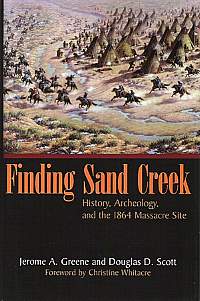 |
Finding Sand Creek:
History, Archeology, and the 1864 Massacre Site by Jerome A. Greene and Douglas D. Scott University Of Oklahoma Press 2004 ISBN# 0-8061-3623-5 cloth hardback The 1864 massacre in Colorado of over 150 Cheyenne and Arapaho at Sand Creek, by 750 US troops and 100-day volunteers led by Colonel John M. Chivington is among the most infamous events in the sad history of American-Indian relations. Black Kettle’s village of 500 believed they were under the protection of federal troops, with both white flag and the American flag flying over his tent, and the slaughter was roundly condemned by a number of federal investigations over the coming years. The federal government in 1998 authorized the Sand Creek Massacre National Historic Site Study Act, under the auspices of the National Park Service (NPS) in anticipation of establishing a National Historic Site in recognition of the event. But the exact location of the site of the Black Kettle’s village had been lost over the preceding 134 years, and Finding Sand Creek is the story of the ultimately successful multidisciplinary archaeological search for the site. Both authors are Indian War specialists and NPS employees involved in this search for Sand Creek. Jerry Greene first “examined all known historical documents – maps, diaries, firsthand accounts by Indian and military eyewitnesses, and congressional investigative reports – that could shed light on the massacre location…as well as the oral histories of Sand Creek descendants.” Aerial photographs and geomorphologic studies were also pulled into play, yet it was the metal detector findings of “local artifact collectors” which pointed out most clearly that the site of the massacre was over a mile north of a monument which had previously marked the supposed site of the massacre. Once led to the actual site by the findings of the avocational archaeologists (as well as by the absence of significant numbers of relevant artifacts at the more southerly site) metal detectors were again the primary tool use for locating artifacts. Spatial layout of the artifacts corresponded well to the historical record and helped determine the Site Survey to determine the location of Black Kettle’s village, the sand pits many of the inhabitants fled to in attempting to escape the slaughter, the approaches taken by Chivington’s men, and artillery locations and even lines of fire. Examination of the artifacts themselves revealed good correlation with those expected by examination of troop munitions lists, lists of trade goods provided by Indian agents and comparison to abandoned goods found at other massacre sites. The Sand Creek Massacre National
Historic Site
is authorized, but so far only 920 acres have been acquired, with most
of the land in its boundary still state and privately owned.
Until
that land is purchased and the site is established, the site of the
actual
massacre itself is not open to visitors. The NPS does maintain a
website for it, which can be located here.
For those interested in the archaeology studies that went are discussed
in the book, the Management
Docs are definitely worth a visit, with 14 lengthy PDF documents on
the sites history, archaeology, legislation and other topics.
Finding Sand Creek
is an intriguing presentation of the practical application of
archaeological
principles in action, rounding out the story of Sand Creek as an
example
of how quickly the locality of a relatively recent, historically
significant
event can be lost and the process of finding it again. It
also
makes clear the important role that avocational archaeologists (in the
guise of “relic collectors” and metal detectors who know more about a
site
location than monument placing historians) can have in working together
with professionals. It can be purchased in hardcover here
, from the University of Oklahoma Press, for $24.95. reviewed
by
Charles
Swenson
|
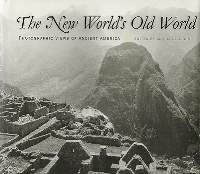
|
The New World’s Old
World: Photographic Views of Ancient America Edited by May Castleberry University of New Mexico Press 2003 ISBN#0-8263-2971-3 oversized cloth hardback Photography has profoundly changed the nature of how we think about the past, freezing it in images of light for the future to contemplate. This delightful book arises from a 2003 exhibition held at the AXA Gallery in New York devoted to the role of photography of New World remnants of ancient civilization in changing concepts of the pre-European culture which gave rise to them. Lavish duotones of ancient American ruins, from South America, Central America and the Southwest United States are chosen to illustrate how photography helped shape public perception of the past of the pre-Columbian civilizations that flourished, declined and disappeared on two continents before the European arrival. The accompanying essays provide the thousand words that prove the worth of pictures in these changing views. The editor, May Castleberry, leads off with an introductory overview of the growing understanding of the Americas beyond the early nineteenth century conception of “a place without a past.” Increased public awareness of the magnificent examples of abandoned architecture was enhanced by the emergent availability of photographs lavishly illustrated travel books and magazines such as National Geographic, often contemporaneous with ongoing discoveries, such as Mesa Verde and Machu Picchu. She also explores how the use of cameras as an art medium has broadened cultural conceptions of what these reminders of the past mean to us today. From the earliest days of daguerreotypes photography was utilized as a tool for documenting ancient monuments, a period of which coincided with discoveries of many Central American sites, as well as many different theories of just what these cultures meant and how they arose. Kathleen Stewart Howe, Curator of Prints and Photographs at the University of New Mexico Art Museum, covers the ongoing use of archaeological and commercial photography of ruined Azetec and Mayan monuments in her chapter, Primordial Stones: Reading Ancient Mesoamerica. She summarizes that, “each photographer found something different when he or she framed some scrap of a remote past. Did they see a proud civilization, a past old beyond comprehension, the loss of spiritual communion, or the mystery of human origins?” The second chapter is contributed by Martha Sandweiss, who has published many other works on the history of photography in the American West. The Necessity for Ruins: Photography and Archaeology in the American Southwest opens with a chilling 1869 daguerreotype from the pioneer St Louis photographer Thomas Easterly. It is the last of a series he made over two decades of Big Mound, one of a series of Mississippian culture earthworks that were gradually destroyed as the growing city overtook them, the artifact-filled dirt hauled off as landfill for the North Missouri Railroad. “Like ruins, photographs allude to the passing of time and inevitably evoke a sense of loss…Ruins speak to change and decay…inviting a viewer to strain, from the evidence of what is to speculate about what was, to imagine a decayed structure whole and a part of a vibrant social world.” This speculation, fed by military expedition, railroad and commercial photographers documenting findings in the American Southwest, reached a peak with the discovery of Mesa Verde. The growing availability of cameras opened opportunities for an increasing number of visitors to carry back clear pictures of this most impressive of cliff dwellings and other ancient sites in the newly opened American Southwest to stimulate curiosity about the vanished cultures that gave rise to them. Edward Ranney, a photographer
specializing
in Andean archaeological sites, focuses on the history of photography
of
South American sites in his essay Images of a Sacred Geography,.
Its
scope is broad, including This wonderful hybrid of art book and
archaeological
retrospection is available in oversized hardcover through the
University
of New Mexico Press, here,
for $29.95. reviewed
by
Charles
Swenson
|
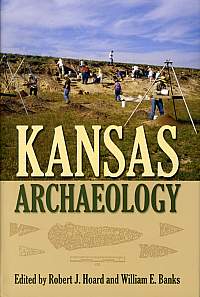
|
Kansas Archaeology
Edited by Robert J. Hoard and William E. Banks University of Kansas Press 2006 ISBN#0-7006-1428-1 cloth hardback With over 12,000 archaeological sites within its borders, Kansas is definitely the source of important materials for researching prehistoric and historic-era America. Also, with archaeological research booming in the past ten years, a new summary of Kansas archaeology was needed, and this book, the first such major overview in over fifty years, fills the bill. One thing really great about the book
is that
discussions of complex topics are written in language all can
understand.
This book is meant to be read by amateurs and avocationalists as well
as
professional archaeologists. The editors seem particularly fond of the
public's desire to learn more about the topic. In the foreword, Hoard
writes
of avocationalists: Kansas is clearly a friend to the amateur and avocationalist archaeologist and this book is meant to answer their questions, too. Contained in over 400 pages is every thing you ever wanted to know about nearly evey facet of research in Kansas. Edited by two of the state's top archaeologists, the book presents papers covering both High and Central Plains traditions, as well as topics synthesizing what is known about the ancient paleolithic residents of the state through to Euro-American contact in the mid-nineteenth century. Here you will also find ethnohistories and ethnographic information about the Wichitas and the Pawnees as well as ethnobotanical and paleoethnobotanical research studies. An extensive chapter is devoted to Kansas Lithic resources. I particularly found interesting the chapter on the little-known Kansa tribe from whom the state is named. So far, five tribes seem to be related to the Kansa linguistically (the Omaha, Ponce, Osage and Quapaw) but the Kansa record is incomplete and the author laments the fact that researchers are ignoring oral ethnographic records in favor of further linguistic studies and that "The word is mightier than the sherd." The book is copiously illustrated with helpful maps, charts and tables. The Appendix is loaded with references that will keep the researcher busy for years. If you are interested in the
archaeology of
this important region, then, get all of the facts in one place by
ordering
a copy of Kansas Archaeology.
In fact, a good library of archaeological books would not be complete
without
this tome, no matter where you live. Order this fine book for $34.95 (a
bargain,
I think, for such a book!) direct from the publisher by clicking here. reviewed
by
Bob
Wishoff
|
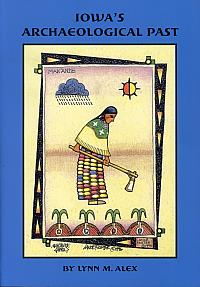
|
Iowa’s
Archaeological Past By Lynn M. Alex University of Iowa Press 2000 1st ed. ISBN# 978-0-87745-680-1 paperback There are more than 18,000 archaeological sites recorded in Iowa and this is the first book in over 20 years to put them all into context and perspective. Like many other of the major summaries of regional archaeology recently published, this volume seeks to update the broad view of Iowa archaeological knowledge in light of recent advances in theory and technology. Also like most of the new volumes, this one is decidedly friendly to the amateur and avocationalist, opening the book with a discussion of the science of archaeology and a history of Iowa research. Subsections of the book's discussions include titles such as "Making a Living" and "Postcards from the Edge" which makes the book a friendly read for non-professionals while still maintaining a high standard for the content. In fact, this book is jam-packed with information about geomorphology, point typology, cultural interactions among Native societies: the entire gamut of archaeological knowledge about Iowa. Not from Iowa myself, I was particualrly interested in the discussions of how the growing of corn changed Native society. The evolution of pottery, always referred to as ceramics, is also quite fascinating and will hold your attention throughout, as will the entire section on Woodland Innovations. As one might expect for this part of the country, the rise of agriculture played a major role in evolving the huge Late Prehistoric civilisations which arose in this area. Considerable time is spent exploring this important point in Native American cultural history. There still remains mystery and much controversy surrounding the great Oneota traditions. Were they one great tribe, or seperate entities spread across a large region, yet sharing cultural traditions? Alex is a very good writer, somehow concentrating thousands of publications into a readable, enjoyable tour through thousands of years of traditions and history. Illustrations, charts, photographs, and drawings are copious and well-chosen for their topics, some would make excellent posters for classroom use. The last chapter concerns the important issues of stewardship and site preservation. The nearly seventy-five page reference section is a boon to anyone hunting for research information about Iowa archaeology, which is not an easy find. Readers will also appreciate the glossary thoughtfully appending the book. Iowa's Archaeological Past
is available direct from the publisher, for $31.00, by clicking here.
reviewed
by
Bob
Wishoff
|
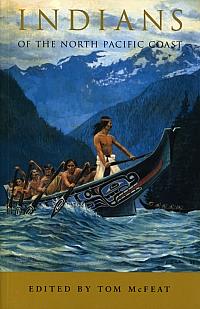
|
The Indians of the
North Pacific
Coast Edited by Tom McFeat University of Washington Press 2002 (Tenth Printing) ISBN# 0-295-74095-7 paperback The First Nations peoples of the Northwest coast between Alaska and Washington developed in a state of relative isolation. The Kwakiutl, the Tsimshian, the Nootka, the Haida, the Bella Coola, the Tlingit, and the Coast Salish were bound by ocean and mountains which hindered travel, and while interactions with peoples further south was not impossible their cultures remained segregated for the most part. This led to unique institutions and societal stratifications which lingered throughout the 19th and 20th century, coloring their behaviors after the advent of Euro-American domination. Not the least of these was the rise of potlatch ceremonies as a form of “fighting with property”, with ceremonial displays of conspicuous consumption as exhibitions of status which at times even led to the ultimate destruction of villages. First printed in 1967, this collection of essays is primarily limited to behavioral anthropology, with a strong emphasis on the potlatch ceremonies particular to the region. As is to be expected with any collection by multiple authors the quality of the writing varies widely. It ranges from John R. Jewitt’s account of being help captive as a slave among the Nootka in the early 19th century, the clarity of Frank Boas writing for the National Museum of the United States at that century’s end, and firsthand descriptions by First Nations natives of potlatch ceremonies to much denser academically oriented papers and even critiques of methodology. While most of the book deals with the surprisingly complex process of accumulation of wealth by means of potlatch, other essays deal with class structures, social stratification, winter ceremonies, crime and punishment. This book is not intended as a
general introduction
to Northwestern coastal Indians, and aside from a few chapters it is by
no means a casual read. But for the reader with a desire to
understand
the social complexities of these peoples on a deeper level, there is a
wide variety material accumulated here that is not readily available
elsewhere.
It’s available from the University of Washington Press for $14.95, by
accessing
the book’s website here.
reviewed
by
Charles
Swenson
|
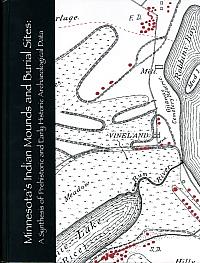
|
Minnesota’s Indian
Mounds and
Burial Sites A Synthesis of Prehistoric and Early Historic Archaeological Data by Constance M. Arzigian and Katherine P. Stevenson Mississippi Valley Archaeological Center/Minnesota Office of the State Archaeologist 2003 ISBN# 0-9726275-0-2 hardback Mortuary and mound sites in Minnesota have been continuously investigated since the 1850’s but summaries of all of this research have never really been put together in one all-inclusive volume. Minnesota’s Indian Mounds and Burial Sites is such a volume: “This major, five-year study represents a truly ground-breaking effort to identify, assess, organize, and synthesize all available data on pre- and protohistoric earthwork and burial site excavations, including original fields data, to develop a comprehensive picture of mortuary practices and patterns statewide… no other state has undertaken such a massive project.” What resulted from that study is a huge, nearly 600 page volume packed with information about every single detail about earthworks and burial mounds that any researcher could wish for. As for amateurs and avocationalists, this book will intrigue you and show you the extent of careful research needed to understand the complex and often puzzling aspects of the archaeology of mounds. Even if you are not from Minnesota, this volume will fill in many details common to other mound builders you may be researching or are interested in. I was especially interested in the papers concerning the structure of mounds, how they were built and the locations of internal features. I’ve not seen this kind of study in other books, even though, mound construction seems to be something most people want to know more about. Minnesota’s Indian Mounds and Burial Sites is the most complete book on this topic available, and this review is meant to act as a pointer for readers to follow up on. Buy this book, you won’t be disappointed. Order Minnesota’s
Indian
Mounds and Burial Sites direct from
the publisher, for $40.00, by clicking here. reviewed
by
Bob
Wishoff
|
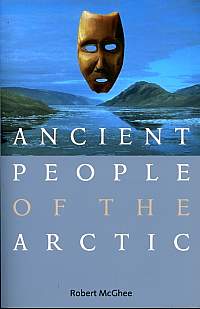
|
Ancient People of
the Arctic by Robert McGhee University of British Columbia Press 2001 ISBN# 0-7748-0854-3 One of the last areas on this planet to be inhabited year round was the North American high Arctic region, and the Palaeo-Eskimos (sic) who spread out from Siberia into this brutal virgin territory 4000 years ago is the topic of this well written and intriguing book. They were a distinct culture from the Inuit which inhabited the region by the time of the Euroamerican incursion, remembered only in Inuit legend as the Tunit and by the archaeological record they’ve left behind. The archaeological record they’ve left behind is scant due to the sparse and widely scattered population that moved along the Northern Slope of Alaska into the Barren Grounds and High Arctic Islands of Canada. But those artifacts which were left behind tend to be virtually freeze-dried by an extremely cold and dry weather that also slows the geological and biological changes that tend to obscure sites. The resulting archaeological record is surprisingly rich and paints a picture of cultural survival and eventual demise at the extreme edges of a harsh environment subject to climatic change. As a curator of the Canadian Museum of Civilization and an archaeologist who has studied ancient Arctic History for over thirty years, Robert McGhee is well qualified to present this study of the Palaeo-Eskimos. His wonderfully clear writing style smoothly brings a personal understanding of the unique ecology of the area and its effect on sites he has worked on and researched. The Neolithic cultures of Siberia, as well as the Choris, Norton and Ipiutak cultures of Alaska are covered to some degree, but the bulk of the book covers the Independence I and II, Saqqaq and Pre-, Early, Middle and Late Dorset cultures of Canada and Greenland, and the ultimate incursion of Europeans. The Palaeo-Eskimos were not related to the later Eskimo or Inuit peoples, and are considered part of a separate wave of Asiatic immigration across the Bering Strait, distinctly different from the influx of 11,000 BP that originally populated North America. For the most part they avoided contact with the previously established populations. They brought with them new methods for dealing with the Arctic environment, including specialized clothing and housing techniques, microblade lithics, and the new technology of the bow and arrow. They are felt to have introduced this latter innovation to the Americas. “Small stone weapon points, which appear to be copies of Palaeo-Eskimo arrowheads, are found on Indian settlement sites in the area occupied about 2000 BC, shortly after the Palaeo-Eskimos arrived. The earliest stone arrowheads on archaeological sites in other regions of the New World appear at progressively later times as one moves farther south and west from Labrador. The Palaeo-Eskimos, therefore, may have been instrumental in introducing an element of Old World technology that became the prime weapon of most New World Peoples.” They were also the first Native American peoples to encounter Europeans as well, encountering the early Norse explorers making their way to Greenland and across to Labrador. Another interesting aspects of this book deals with the effects of ongoing climatic changes on Paleo-Eskimo culture, for, as McGhee states, “(o)ur culture is not the first to face a major shift in global climates…Arctic climates are so severe, and human adaptations to them are assumed to be so marginal, that any significant change in he environment could be expected to cause major problems for the people adapted to it.” The relatively rapid climatic changes of the Mediaeval Warm Period and the Little Ice Age produced alterations in caribou and musk ox migration patterns, as well as changes in sea ice environments, radically altering subsistence gathering capacity. The fragility of their cultures, based as it was on exploiting an already marginal environmental niche, may have been unable to cope with such a decline, ultimately leading to the demise of the Palaeo-Eskimos. Ancient People of the Arctic is quite nicely illustrated. The photographs, many taken by McGhee himself, not only give a good feel of the archaeological sites and artifacts, but of the environment the Palaeo-Eskimos thrived in. A series of color plates convey the mystery of art that thrived not only in shamanistic masks and amulets, but in beautifully rendered lithics and objects of daily life. A wide number of maps are also very helpful for those of us lacking a clear understanding of this often forgotten corner of the globe. Eminently readable and appropriate
for both
professionals and amateurs wanting to learn more about this little
known
facet of North American archaeology, this is the book to start with on
the subject of Palaeo-Eskimos. It’s available in paperback for $29.95
from
the University of British Columbia Press, via the book’s website here.
reviewed
by
Charles
Swenson
|
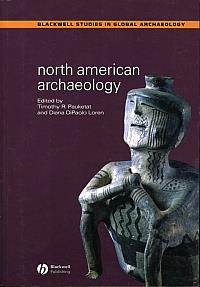
|
North American
Archaeology by Timothy Y. Pauketat and Diana DiPaolo Loren Blackwell Publishing 2005 ISBN# 0-631-23184-6 paperback How many times have you bought a book because you picked it up, read part of a chapter and realized that this was the book for you? While easy enough in a bookstore, it is more difficult for online purchases. But try this: take this opportunity to view the book’s first chapter at leisure. Go ahead, click here (a PDF), take your time, and then come back to finish this review. Blackwell Publishing publishes their Studies in Global Archaeology as “a series of contemporary texts, each carefully designed to meet the needs of archaeology instructors and students seeking volumes that treat regional and thematic areas of archaeological study.” This volume, which presents a range of North American archaeology that stretches from the prehistoric to the recent, falls well within their stated goal of being accessible while offering a theoretically sophisticated overview of what archaeology has to contribute to understanding 10,000 or so years of cultures on this continent. The academic constructs underpinning research into North American archaeology are undergoing constant changes, and here one will find a wide number of them discussed in a lively fashion. The editors set the tone in their co-authored first chapter, ‘Alternate Histories and North American Archaeology.’ Although this entire chapter is available for viewing on the book’s website, it is insightful to quote their take on this collection. “The chapters in this volume highlight the story of a continent, from the Atlantic to Alaska, from the San Luis mission to Sonora, and from the Kinnewick man of nine millennia ago to the Colorado coalfield strikes of nine decades ago….North America is, and was, all about alternative histories. It is about peoples in the plural…Alternative histories are the subject matter of a renewed North American archaeology that, in its own history of practice, its large datasets, and its theoretical directions, is teaching us a lesson that promises to help all peoples understand the sweep of global history and the commonalities of the human experience.” The following 14 chapters follow in a roughly chronological order covering specific periods and locales, liberally seasoned with case studies emphasizing the contemporary research developments in those fields. Starting with the peoples who first ventured onto this continent (“…the event is all but invisible archaeologically”) and the Clovis phenomena (“…not a unitary lifeway but…a brief artifact-signaled moment when many different lifeways appear to have coexisted”), the chapters move on to cover examples of the evolution of increasingly complex societal structures along the Pacific coast. Next covered are the mound building cultures of the archaic Southeast, Hopewell and the Mississippian periods, which are particularly rich in the archaeological record, especially with regards to mortuary practices. The current state of research regarding these large and complex societies are addressed in regards to the questions they raise regarding a more stratified leadership hierarchy and degrees of social inequality in the context of agrarian stabilization of subsistence levels and an increase in intra-and inter-regional trade items. The pre- and post-contact evolutionary curve of Plains Village cultural traditions in adapting to advances in agricultural and hunting technology is traced over a millennium that encompassed interactions with first Cahokia and then white men. The highly mobile Algonquian culture of the Northeast is seen here through the archaeological record in “…multilayered contexts of power relationships, social organization, cultural traditions, environment, and history.” The recurring issue of archaeological evidence of social inequality and “the emergence of elites” amongst the Hohokam, Mogollon and Anasazi is dealt with in a chapter on the Southwest in general, and more specifically in a chapter on Chaco which carefully contrasts earlier, more idyllic views with contemporary research on both Chaco and Paquime. The final five chapters focus on the emergence of archaeology as a valuable adjunct in the interpretation of the historic record. Post-contact Indian culture, the emergence of creolization of the native population, integration of the slave population in colonial America, and issues regarding repatriation of Native American burials (including NAGPRA) are each given a chapter that emphasizes the importance of interpretation of artifacts in clarifying history. A final chapter on archaeological finding at the Ludlow Massacre Site where less than a century ago armed struggle between coal mine management and labor makes clear that the subject of cultural inequity still has a very real relevance, one that can benefit from hard archaeological data in the face of emotionally charged discussions. While the academic credentials of the authors (including a strong showing of anthropologists) clearly show through in the referential thoroughness of their work, the writing is clear and flows naturally between case studies and debates on their implications. While this is not a complete text on the subject of North American archaeology enough background material is provided throughout that it is capable of standing alone. The large number (over 90) of maps, diagrams and illustrations are well chosen and much more of an asset than an added afterthought. As well suited for the student of archaeology as for the
layperson
wanting to follow recent conceptual trends in the field, this book will
provide much food for thought. The bibliographies at the end of
each
chapter provide excellent suggestions for readers who want to delve
deeper
into subjects, while the glossary actually amplifies the contextual
content
of terms. For a volume you will return to many times, this 410 page
paperback
volume is well worth its price of $36.95 ($89.95 in hardback) from
Blackwell
Publishing. You can purchase it through the book’s web page by
clicking here.
(This
page also contains the table of contents and a ‘View sample
pages’
icon leading to the first chapter.) reviewed
by
Charles
Swenson
|

|
1491 New Revelations
of the
Americas Before Columbus by Charles C. Mann Alfred A. Knopf, 2005 ISBN 1-4000-4006-x (alk. paper) There are few books that shake the foundations of our
culture. This
fascinating book does it. Mr. Mann's writing brings together a vast amount of
research and
theory, not shying away from perspectives that discount a position, but
presenting ideas that make the hair on the back of your neck stand
up. The first explorers reached land and were greeted by people who were tall, healthy, and clean. The native diet was better than the food we have available to us today, and is the foundation of the Thanksgiving image of vegetables and meats. Those vegetables were grown in plots called 'milpas' which had a mix of corn, sqash, beans, tomatoes, chiles, avocado and more. There are milpas in constant use for over 4000 years. The first explorers reached land to find lots of people.
More people
than they ever imagined. They wondered if there would be room to build
cities. A dozen years later, explorers reported the land empty. A vast
graveyard. Smallpox had propagated from the coast inland, and decimated
populations. 1491 New Revelations of the Americas Before Columbus is not a history book. Not a chronology. Not the tome of an archaelologist. It is to be read and enjoyed. The biggest paradigm shift for this reviewer is that a huge branch of human development was lopped off, and with it went a diverse gene pool, art, science, philosophy, languages, government ... imagine if Europe or Asia had met a similar fate. In this reviewers opinion, if this book were made available to every classroom in the Americas, it would change the future. It would give the children of the Americas a fresh perspective on their past, and for those who don't already know it, the realization they are of a unique and accomplished lineage. For those who have roots elsewhere, a new respect in the lands and people and history of the Americas. The reviewed copy (5th printing) is 460+ pages, and has a nice index and huge bibliography. Paperback edition sells for $14.95 at most retail and web book stores. Reviewed by Don
Rathbun
|
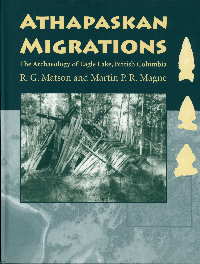 |
Athapaskan Migrations: Much is known about how migration has influenced culture throughout the North American continent, but little is known about the actual timeframes and passage. What is hinted at can be seen in linguistic affiliations between the northern Athapaskan-speaking tribes and the Southwestern Athapaskan-speaking Navahos: one example-- both describe themselves as “Dine,” which means “The People.” This would seem to indicate a migration from the North, but this is difficult to prove from within the archaeological record, i.e., from the material remains. In Athapaskan Migrations, the authors discuss 25 years of research into migrations of the Athapaskan-speaking Chilcotin Indians into interior west central British Columbia from western British Columbia. What is most significant about this book is that the authors have contrived and tested many new methods for the inference of migration from within the archaeological record. As such, the book will be of particular interest to archaeologists, cultural anthropologists, linguists and Athapaskan scholars alike. Aside from the
background chapter on the project’s history,
others cover methodology, settlement patterns, investigation of Plateau
Pithouse and British Columbian Athapaskan Traditions, ethnic
identification of
excavated materialism, the Chilcotin migration and its implications of
the
greater Pacific Athapaskan, Navaho and Apache migrations, as well as
summaries
of the excavations. Athapaskan Migrations can be
ordered direct from the
publishers for $65.00 (cloth hardbound) by clicking here. reviewed
by
Bob
Wishoff
|
 |
Miskwabik “Miskwabik means
‘copper’ in
the Native American language of the Ojibwa tribe.” That copper was
central to
five major ritual manifestations in eastern North America there has
never been
an argument. The Old Copper Culture, the Adena, Hopewell, Copena and
Southeastern Ceremonial Complex peoples all used copper but
for many years scholars were unwilling to believe that Native Americans
had the
wit to exploit deposits of native copper. It has only been in the last
three
decades that techniques have been developed to source copper and in
many cases,
the locations of mines were closely kept secrets. As well as
exploring what the author calls "a consistent history" of copper use by
Native Americans, there are also chapters exploring "Meaning and
Significance in Design and Material", "Copper: Its Ceremonial Role",
and also includes a comprehensive Appendix that explains, among other
things, the methodology of the analysis of motifs used in copper
artifacts-- an invaluable reference in itself! The Appendix also
includes maps, further notes and data tables refered to in text. One interesting
observation made by the author is that artifacts made of copper from
the Amercan Northwest are similar to some found in eastern North
America! Trevelyan posits that the material had similar meanings to
Native American across the continent, positing the copper's red color
makes it easy to associate with blood, or other things red, such as
salmon flesh. Miskwabik is an incredibly
interesting book on a topic rarely discussed in such depth! You'll
enjoy every word of it. Miskwabik
is available directly from the publisher, for $50.00
(hardback) and can be ordered by clicking here. reviewed
by
Bob
Wishoff
|
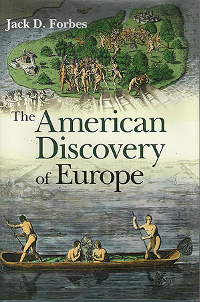 |
The American Discovery of Europe
reviewed by Charles
Swenson
|
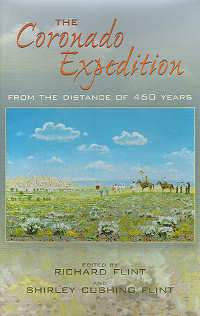 |
The As the first major encounter between the European exploring what was to become the American Southwest and its indigenous peoples, the Coronado Expedition was well documented. There is also an increasingly large body of archaeological evidence which lends balance to what is the often ambiguous or incomplete record left to us from the participants and the inevitable paper trail demanded by the Spanish bureaucracy of the time. This synthetic protohistorical approach, at least for this reader, provides the most exciting type of historical account. The interface between the artifactual evidence of prehistoric cultures and the written records of a literate society first encountering them allows for a reification of the events which is not only mutually enlightening but often reveals more than either method is capable of uncovering on its own. The 17 essays in The Coronado Expedition present a delightful combination of the insights resulting from such a collaboration. They are gathered from the conference on “Contemporary Vantage on the Coronado Expedition through Documents and Artifacts” held in 2000 at two locations. One venue was the New Mexico Highlands University, where work has been done on translating into English documents related to the expedition, and the other near the Jimmy Owens Site in the Texas Panhandle, where a campsite from the expedition has been uncovered. reviewed by Charles
Swenson
|
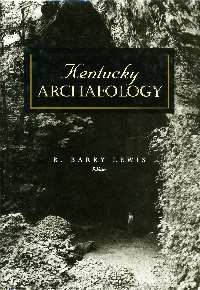 |
Kentucky
Archaeology
Kentucky has a rich and colorful history of archaeological investigation. Beginning with the eccentric and controversial Constantine S. Rafinesque (click here for more info about Rafinesque) who, in the 19th century identified 148 prehistoric indian sites there and continuing through William Snyder Webb (the "driving force" behind professional archaeology in the state), Kentucky has been the source of a vast amount of important archaeological data. Whether you are a professional needing a great reference for Kentucky in your library, or an amateur living in Kentucky who wants to learn about its history, this book will not disappoint. This book is a true bargain! Order it direct from the publisher's website and the hardback edition is yours for only $22.40... click here to order. reviewed
by
Bob
Wishoff
|
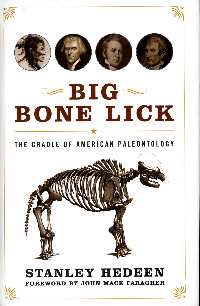 |
Big Bone Lick: The Cradle of
American
Paleontology According
to
a letter from then-President Thomas Jefferson to a French
naturalist, one
of the lesser known goals of the Lewis and Clark expedition of 1803 was
to search out for any possible evidence of live mammoths or
elephants. Odd as this may sound, it
makes more sense when one realizes that Jefferson knew of the
surprising amount of "elephant" skeletal remains
that were emerging from Big Bone Lick in the late 18th and
early19th
century. This
ancient salt lick has
attracted salt-craving creatures for over ten millennia. The skeletal
remains found there eventually included not only woolly mammoths but
American
mastodons, ground sloths, elk-moose, American bison and other animals,
seven of
which had been extinct since the end of the last Ice Age.
It
is
the influence of the fossil bones, teeth and tusks on the emerging
science
of paleontology that serves as the focus for most of this book. George Washington, Benjamin Franklin, Lewis
and Clark, and Daniel Boone were intrigued by reports of these
mysterious
relics and Thomas Jefferson actively encouraged their collection. Early French scientists such as Georges
Curvier, Jean-Baptiste Lamarck and Georges-Louis Leclerc de Buffon
received
specimens and regularly correspondended regarding them (many of the
extant fossils
still remain in France). Pioneering geologist Charles Lyell visited the
site
with an eye to ascertaining the age of the remains found there. Stanley
Hedeen
has managed to pull the many diverse
threads of this story together into a coherent and fascinating whole,
drawing
on his expertise as a natural historian and Emeritus Professor of
Biology at
Xavier University. It is currently only
available cloth-bound, 182 pp with 37 illustrations, for $24.95-- order
it direct from the
University of Kentucky Press (by clickcing here
-- where you
can also see a Google-powered limited preview of the book.
For
those
interested in visiting the site, Kentucky
has preserved elements of it as Big Bone Lick State
Park, open year
round with 3.5 miles of hiking trails around its mineral springs and
lake. reviewed
by
Charles
Swenson
|
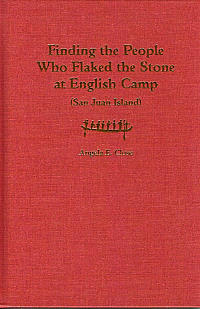 |
Finding the People
Who Flaked the Stone at English Camp In this book, Angela Close focuses more on the crystallized volcanic rock artifacts uncovered from a ridge of shell mound investigated during the later part of a field school held at the site from 1983 and 1991; little other sorts of flaked material was found there. She utilizes the chaine operatoire to look at the full range of manufacture of material, including cores, blanks, tools other than bifaces and associated debitage. Her approach takes the broader view of raw material procurement, tool production and tool kit management. Her findings indicated that most of the artifacts previously dismissed as debitage had a gender based usage in food processing, making use of “larger flakes that were consistent in proportion and had a cortical back. These were the foundation of their tool kit.” The flakes used by men tended to be thicker, larger, feathered at the ends and without cortex. Those used by the men were different “in almost every respect” from those used by the women in the community, which were more expedient and generally not resharpened or reused. The result is a “somewhat speculative synthesis of the chaine operatoire, with a greater emphasis on its relationships with other subsystems within society.” This monograph is essentially an
expansion on a paper
submitted by the author at the April 2004 Society of American
Archaeologists, a
14 page copy which can be found at Chaîne-Opératoire
Analysis of a
Northwest Coast
Lithic Assemblage.
The book is a much
larger expansion (189 pp) on her
thesis, and can be purchased from contacting the University of Utah
website here,
for $45.00. reviewed
by
Charles
Swenson
|
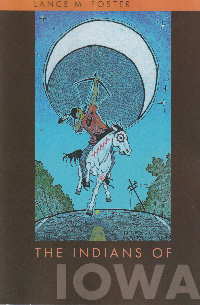 |
The
Indians
of
Iowa “The Indians of Iowa” is Foster’s effort to present an introduction to this subject to the general public. The book covers some 25 tribes which at one time or another made Iowa their home. After opening with a chapter on the role of Lewis and Clark in Iowa history, the following ten chapters focus on associated tribes. Each of these chapters opens with a list of basic factoids (‘Name means’, ‘Other names’, ‘They call themselves’, ‘Language spoken/language family;, ‘Residence in Iowa’, ‘Location today’) and concludes with ‘A Closer Look’ section on broader subjects (‘Indian Women in Iowa’, Archaeology in Iowa’, ‘Indian History’, ‘Do you have Indian blood?’, ‘Going to a Powwow’, ‘Indians in Iowa today’). For those living in, or for those traveling through Iowa, there is a geographically-based section on ‘Places to Visit’ (archaeological sites, a large number of mounds (including Effigy Mounds National Monument, which includes 200 mounds, 31 of which are effigies), historic sites, museums, and even casinos). ‘Tribal Contacts’ includes information on getting in touch with tribes, including some official tribal websites, while ‘Recommended Books and Websites’ includes a bibliography based on tribal affiliations and a separate section for younger readers. This 160 page paperback, with maps and
illustrations by
the author, is available for $16.95 here. The author’s website, Baxoje, the Ioway Nation,
is
also
definitely worth investigating for several of his articles in Ioway Virtual
Library
section on ‘The
Ioway
and the Landscape of Southeast Iowa’ and ‘Tanji na Che:
Recovering the Landscape of the Ioway,’ both
of
which are fascinating articles in their own right,
as well as a
Google-ized pdf file of a 1911 out of print W.H. Miner book, ‘The
Iowa.’ Check
them out! reviewed
by
Charles
Swenson
|
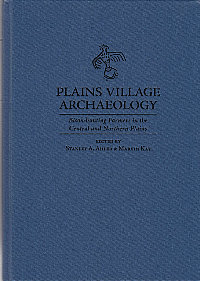 |
Plains
Village Archaeology This interesting volume is the result of a symposium held in honor of W. Raymond Wood at the 69th Annual Meeting of the Society for American Archaeology held in Montreal Canada in 2007. Wood is currently Professor Emeritus at the University of Missouri-Columbia. Wood's website notes that "I am interested primarily in the archaeology, ethnohistory, and Quaternary paleoecology of the North American Great Plains and Midwest states of North America, particularly the environmental and processual bases for the culture histories of these areas." And as you would have it, that is the main theme of this book: a collection of publications that explore the environmental and cultural history of the Central and Northern Plains. Chronology building and space-time relationships, always important elements of research in this region, are important factors of nearly every paper presented in the volume. What emerges from the papers are the dynamics of Plains Village life-- the idea that the people themselves were better suited and more flexible in their responses to environmental changes that were others in other parts of the Plains. In fact, the main thesis of the volume is that the Plains peoples created an entirely new lifestyle--- a society created in structural, transformitive events: the domestication of landscapes, the growing of corn and other crops, the exploitation of wild animals, and the design and use of the earthlodge "as a physical dwelling and the prime metaphor of life itself and the cosmos." And there were the relationships they evolved, trading partners nearly spanning the continent and lasting well through the historic period. In their paper, Assessing Plains Village Mobility Patterns on the Central Plains, Roche M. Lindsey and Richard A. Krause present evidence that " for at least four centuries, from roughly A.D. 1000 to A.D. 1400 and perhaps for several centuries more, the Colorado High Plains were occupied by indigenous drifters"-- ceramic-producting , hunter-gatherers perhaps confused with Upper Republican peoples. This kind of research underscores how much more there is to be discovered about this critical part of the Great Plains, and its peoples' influence on the surrounding region. Divided into five parts, Plains Village Archaeology, presents papers covering Origins, Peripheries, Heartland Material Strategies, Heartland cultural Landscapes and Historical Studies, all by some of the regions best scholars and pundits. It is quite simply a must-have book for anyone at all interested in the archaeology of the Great Plains, and not just specifically the Central and Northern Plains. The University of Utah is a true leader in the publication of tomes about the American Plains, and this book is one such fantastic resource--- be sure to take a look at the full catalogue on their website before you check out. Plains Village Archaeology retails for $50.00 (hardback), and can be ordered directly from the publisher by clicking here. reviewed
by
Bob
Wishoff
|
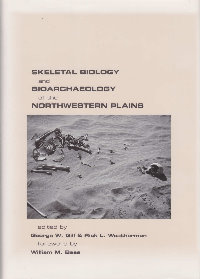 |
Skeletal
Biology and Bioarchaeology of the Northwestern Plains The skeletal and burial record of the Northwestern Plains spans thousands of years and holds important evidence of how people lived in this important and vast section of North America. Author Gill, defines the Northwestern Plains a little differently than the classic area as defined by Wedel in the 1960s. Gill's NW Plains encompasses an area roughly bounded by Montana to the North, and all of Wyoming to the South, including the Wyoming Basin, a compromise with both Wedel's and Frison's vision of the area. It is Frison's 1991 chronology that is followed by the editors, and which "has guided" much of the presented research. After George Frison's presentation of a history of how records of human burials were kept in he "early days"-- a most interesting paper-- Laura Schreiber gives us an overview of "Life and Death on the Northwestern Plains: Mortuary Practices and Cultural Transformations". One interesting fact: to date only nine individuals have been recovered from Paleoindian, Early Archaic and Middle Archaic contexts. Though a pretty technical read, the authors do such a good job articulating background information, that I can honestly say I had no problem understanding most of the skeletal analyses. Most of the contributions assembled here were initially presented as part of a symposium at the Plains Conference in Oklahoma City in 2003. The wide scope of the book, time-wise, means that the reader is sure to find something interesting to focus on. Not only are remains from Native peoples examined, military and pioneer remains are also analyzed. One such skull, that of a railroad worker, had a healed saber wound... fascinating. Grisly realities abound, such as in the unburied remains of a gunshot victim found in a sand blow-out in 1996. This person was shot in the back of the head with a .44 or .45 caliber bullet, then hastily covered over in sand and abandoned. This is an interesting and unique book. If the American Plains is your area of interest, you will definitely want this book in your library. The University of Utah is a true leader in the publication of tomes about the American Plains, and this book is one such fantastic resource--- be sure to take a look at the full catalogue on their website before you check out. Skeletal Biology and Bioarchaeology of the Northwestern Plains retails for $50.00 (hardback), and can be ordered directly from the publisher by clicking here. reviewed
by
Bob
Wishoff
|
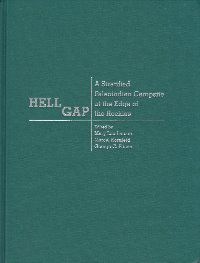 |
Hell Gap Hell Gap is surely one of America's best-known and most interesting known Paleoindian sites. This book is an attempt to, for the first time ever, to bring together most, if not all, of those known data about the site. Here we are presented with everything you could ever ask to know about the natural history, cultural history, adaptive stystems and technological strategies concerning research of the Hell Gap Site. Of particular interest to most will be the fact that all of the relevant collections have been brought together for the first time, making a true picture of the entire assemblage much clearer. We are treated to the first true summary of over 50 years of research work. We are treated to the first true synthesis of research work on the site. There simply is no way a serious student of Paleoindian culture and envirenment could possibly justify not owning this book. A wonderful, marvelous reference that is well-written and well-thought out. The University of Utah is a true leader in the publication of tomes about the American Plains, and this book is one such fantastic resource--- be sure to take a look at the full catalogue on their website before you check out. Hell Gap retails for $60.00 (hardback), and can be ordered directly from the publisher by clicking here. reviewed
by
Bob
Wishoff
|
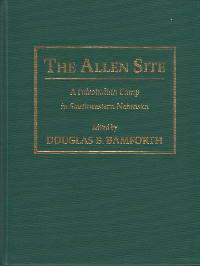 |
The Allen
Site What emerges is a far more complex picture of a "place-oriented", rather than "technology-oriented" way of life, one closely linked to specific areas of the Plains. "Paleoindiand archaeology on the Plains is thus at a kind of turning point, in large part because evidence accumulating from detailed analyses of new sites and existing collections paints a picture that is increasingly at odds with the views that have dominated the field in the past." The Allen Site is a fascinating and incredibly thorough and complete study of one of America's most interesting Paleoindian Camps. But this book is not just about the Allen Site, but instead will give the eager reader a big picture view of an entire paleo-ecology, complete with an emerging picture of paleoethnographic use of the landscape. Quite simply, the book on this site, period. No library of paleoindian research materials would be complete without a copy of this book. A great source of citations--- couldn't imagine writing any kind of paper about this time period with citing something from this book-- also has very good bibliography for further research. The Allen Site can be ordered directly from the publisher ($55.00, hardcover) by clicking here. reviewed
by
Bob
Wishoff
|
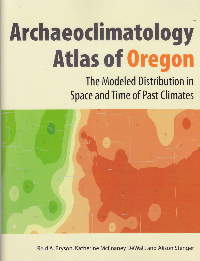 |
Archaeoclimatology
Atlas
of Oregon Here is one unique book for your perusal. Using what is known as the Macrophysical Climate Model, the editors present an innovative and in-depth means for modeling of past climate that has been rigorously tested and verified. One of its editors, Reid A. Bryson, recently passed away, was an emeritus professor of atmospheric and oceanic sciences, geography, and environmental studies at the University of Wisconsin, Madison. He authored seven books and more than 250 other publications ranging over the fields of geology, limnology, meteorology, climatology, archaeology, and geography. His book, Climates of Hunger, received the Banta Medal for Literary Achievement. What we are presented with is literally an atlas, jammed with 307 charts and maps that detail precipitation, temperature, evaporation and snowfall for more than 75 locations in Oregon, and going back over 14,000 years! This is a unique book, that will be of interest to anyone who seeks information about paleoclimatology. Ordera copy of this book directly from the publisher ($50.00, oversize paperback) by clicking here. reviewed
by
Bob
Wishoff
|
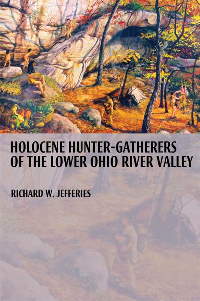 |
Holocene
Hunter-Gatherers
of the Lower Ohio River Valley By
Richard W. Jeffries University
of
Alabama Press 2008,
1st edition This
is a book that compiles a huge amount of information into a concise,
and
creative, assessment of known information and research into a time
period that
stretches from 12,500 years ago to about 3,000 years ago, when the
primary
means of human subsistence was through hunting and gathering of food
and
supplies—a time before agriculture. “Jefferies
centers his research on a 380-mile section of the Lower
Ohio River Valley, an area rife with both temporary and long-term
Archaic
sites. He covers the duration of the Holocene and provides a compendium
of
knowledge of the era, including innovative research strategies and
results.
Presenting these data from a cultural-ecological perspective
emphasizing the
relationships between hunter-gatherers and the environments in which
they
lived, Jefferies integrates current research strategies with emerging
theories
that are beginning to look at culture history in creative ways.” This
is a book filled with detailed information. Anyone seriously
interested in the Archaic period in North America would find this book
an
important resource. Not only are the facts alone important to the
researcher,
but also of extreme interest are the creative research strategies and
interpretations that Jeffries employed in his work. This
fine book can be ordered directly from the publisher by
clicking here.
The
University of Alabama Press offers an
innovative three ways to get this volume—cloth hardback ($60.00),
paperback ($36.95),
and in an e-book format ($29.56). I hope more publishers follow this
format! reviewed
by
Bob
Wishoff
|
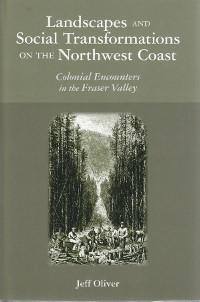 |
Colonial
Encounters in the Fraser
Valley Among
the most popular topics in the archaeological press are tomes
concerning
landscape archaeology and those concerned with the interactions between
White
and Native Americans. This book covers both topics, and does it very
well
indeed. Right
away, author Jeff Oliver gives us a big picture he does not want you to
forget.
He describes an aerial view of the land that is the focus of his
studies ---
here is how the land has been adapted by its inhabitants. In
interpreting this
scene, historians created “a history that reads largely as a protracted
process
of human impact on the environment.” The
author is not happy with how we view this purely exploitative view as
representing the true history of the region. Oliver
credits
Eric Wolf as being one of the first to criticize accepted narrow views
of history. Wolf argued that the capitalist/adaptation “top-down model
of
social development… privileges historical developments at the core,”
ultimately
eroding the line between wilderness and civilization. Oliver rails
against
viewing colonial cultures and their relationships to the landscape in
such a
monolithic, objectified way, and puts forth this book as a rejection of
this
kind of thinking. The author tells us that he wants “to entertain a
view of the
landscape that engages the social experiences of people living in the
past,
individuals as well as larger social groups.” This might form a more
ambiguous
and messy picture of the past, but landscapes, writes Oliver, “are not
just
static, given, or objective things.” The
true relationship, or engagement, of people with their landscape is the
theme
of this book. Oliver considers the appropriation of the land by Native
peoples, and he looks into how colonists
networked the landscape, thus, creating artificial geographies, and
notes the
historical consequences of all of these actions. This book is both
thoughtful
and insightful, and will be cited aplenty in many research papers to
come. reviewed
by
Bob
Wishoff
|
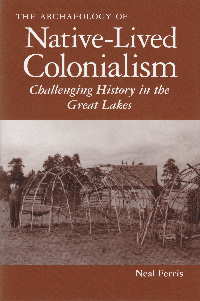 |
The Archaeology of
Native-Lived Colonialism: Challenging History in the Great Lakes by Neal Ferris The University of Arizona Press 2009 1st Edition ISBN 978-0-8165-2705-2 The colonial concept has historically been applied in America to the colonizers rather than those whose land has been colonized. This book is the initial offering of a series that focuses instead on “…research that stresses the connectedness of the precolonial and colonial, studies that recognize that colonial change did not happen in a cultural vacuum and that change is based on local conditions and historical trajectories seated in precolonial cultural forms…”, utilizing archaeology as “…a model for evaluating how the prehistoric may differ from the historical and ethnological.” Although the work done in this volume has further reaching implications, its emphasis is on the Ojibwa, Delaware and Iroquois of what is now southwest Ontario. Neal Ferris, who now holds the Lawson Chair of Canadian Archaeology at the University of Western Ontario, draws upon his 20 years as an archaeologist for the Ontario provincial Ministry of Culture, including a period of time when the Six Nations Iroquois were seeking involved in reclamation of lands in Southern Ontario where sovereignty issues were in dispute. As he puts it …“(t)his book is about reading the past through an archaeologically informed perspective --- archaeological history--- to construct an understanding of how Native communities in southwestern Ontario negotiated the rise of colonialism in the 18th and 19th centuries through a process of changed continuities…situating the past as the prosaic and daily decisions and choices that individuals, families and communities make, informed by the way the world works at that moment based on past knowledge and future expectations.” Utilizing the archaeological record allows for an investigation of the continuity of Ojibwa lifeways from the time of initial British contact to the primary temporal focus of this volume in the eighteenth and nineteenth centuries. The impact of this colonization is undeniable, yet a strong sense of cultural identity was maintained until major changes in mobility, subsistence and trade patterns that began to demand adaptation in the mid-nineteenth century. Ferris also looks at the adjustments among the Delaware refugee communities established by Moravian missionaries in the Great Lakes region and investigates the necessary social and cultural modification of the Iroquois by British demands and previously colonized peoples in this region. While this is an important work in understanding the role colonization played on indigenous peoples the southwestern Ontario region, it also is a valuable contribution to understanding the significance of the archaeological record as an important source of data at least equal to the written record, especially in an area where the written record is so heavily weighted towards the colonizers, rather than the colonized. This is
the second of two books by Neal Ferris dealing
with the early historical archaeology of southern Ontario. It’s
available from the University of Arizona
press here in
hardback (240 pp, with numerous graphs and maps) for $50.00. For
the interested reader, I strongly advise
also visiting the author’s website
where he has posted related papers (Telling
Tales:
Interpretive Trends in Southern Ontario Late Woodland Archaeology
and Between Colonial and
Indigenous
Archaeologies: Legal and Extra-legal Ownership of the Archaeological
Past in
North America). He has also
posted a
link to a wildly hilarious and delightfully insightful paper he
presented
entitled Fear and Loathing Archaeology, or, Befuddled
Bureaucrats &Contemptible Consultants – Lies My Career Taught Me.
This one is good for a laugh and well worth taking a peek at for
insights on
some of the more irritating issues confronting archaeologists. reviewed by Charles Swenson |
| Home | Gallery | Latest Finds | Back to Main Book Review Index |